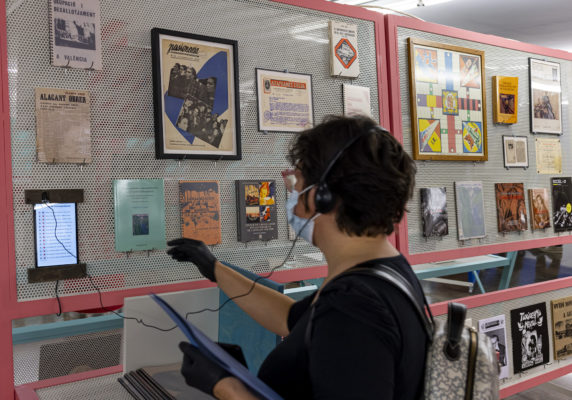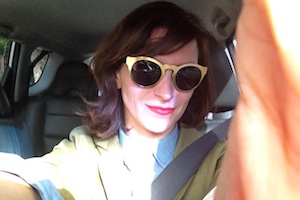Search
To search for an exact match, type the word or phrase you want in quotation marks.
A*DESK has been offering since 2002 contents about criticism and contemporary art. A*DESK has become consolidated thanks to all those who have believed in the project, all those who have followed us, debating, participating and collaborating. Many people have collaborated with A*DESK, and continue to do so. Their efforts, knowledge and belief in the project are what make it grow internationally. At A*DESK we have also generated work for over one hundred professionals in culture, from small collaborations with reviews and classes, to more prolonged and intense collaborations.
At A*DESK we believe in the need for free and universal access to culture and knowledge. We want to carry on being independent, remaining open to more ideas and opinions. If you believe in A*DESK, we need your backing to be able to continue. You can now participate in the project by supporting it. You can choose how much you want to contribute to the project.
You can decide how much you want to bring to the project.

07Before entering, a siren sounds every hour. Its sound is sometimes mixed with the voices of demonstrators: a call to what? a demonstration of what? who is summoning us to a side room of the museum?
It’s not a typical exhibition. There are no curators articulating a narrative proposal, but a project open to speculation that uses the tools of the curatorial, as well as the archeology and sociology and what we identify as art. There are no artists on a list, but a list of people, collectives, choirs, institutes, universities, laboratories, and other participating and collaborating associations. Nor are there works placed with “air” around them. The only pieces that refer us to a classic exhibition format are machines for learning how industrial systems work, from the industrial machinery collection of the Alcoi campus of the Universitat Politècnica de València.
Industry / Matrices, threads and sounds is conceived as an investigation, a critical reflection and an open process to rethink the concept of heritage, specifically Valencian industrial heritage, both material (the classical architectural vestiges, including the romanticised ruins) and immaterial (sounds of machines, work songs or examples of rave music, together with the oral testimonies of members of social movements of citizen participation, from anarchism to trade unions or neighbourhood associations). It has been initiated collectively thanks to the complicit work of research, archiving and, now, activation, of an archaeologist, Tono Vizcaíno, and an artist and curator, Lorenzo Sandoval. First invited by Sergio Rubira, former deputy director of the IVAM, and encouraged to continue and expand the project by the new direction of Nuria Enguita, they have been responsible for starting a tour of several of the fundamental places in the official history of industrialisation and collectivisation in this region: Alcoi, Elda and Elche/Elx in Alacant, Port de Sangunt in Valencia, and L’Alcora and Onda in Castelló. They have found there the first institutionalised registers, which have helped them to ask questions and bring together more examples hitherto unconsidered, many forgotten and, in many cases, the fruit of a desire born from the informal margin. One archive has led to another, and another, and another… until a first nucleus of records and documents has been formed to form the collection which, from now on, will be part of the IVAM library.
The idea of an archive, a collection and a place where a selection of objects and documents are gathered and guarded, to which a very precise value is given, is at the genesis of the idea of the Western museum as a Wunderkammen. In them, one treasured what one wished to possess, what one wished to retain in time as a symbol and/or image of a certain conception of the world and its organisation, as part of a very precise grammar for the creation of a civilising imaginary, a story that would support and justify the existence of a power. Today, rereading the determinist version of the Enlightenment, as well as through the different decolonial or gender theories, an archive should be approached from an open, mobile and always under construction pattern. And this, for me, is the great success of Industry, in its content, its form and its attempt at current design.
To look at our history from a materialist viewpoint, understanding who controls the means of production, would always remain lame if we do not also understand the means of dissemination and control of its message, and its associated image. Studying only the large structures of this machinery has also been insufficient, because they are exclusive, and the task now is to complete it, to fractalise it in the multitude of discordant, infiltrated and, in its essence, subaltern voices. To this end, magazines, leaflets, posters, documents, album covers, albums and photographs are brought together here, which make a genealogy of the image and graphics that shaped the culture around the industrial, from the 1930s to the 2010s, with some examples from the late 19th century. But not only “paper”, which is on the verge of becoming another romantic fetish, but also a whole variety of examples of what is considered “immaterial”: recordings of speeches, songs, machine sounds, radio broadcasts, which by their own non-objectual characteristic have served as a place for the manifestation, through desktop publishing, of what is diverse and critical of a hegemonic power. In this way, different lines can be traced that unite histories that have not traditionally been contemplated or heard together, and that can provide many keys to understanding or rethinking ourselves.
Following the idea of “good neighbourliness” of the Warburg atlas, in this room one can hear the sound of a mechanical loom to the experimentation of electronic music throughout the 20th century, reaching as far as the Valencian “machine” sound. In this amalgam of sound and diachrony, between the traditional and the avant-garde, one can understand the scenario of the factory and its life (patronised, collectivised, intervened, abandoned) as a space of social analysis that concerns us all. It is no coincidence that this exhibition is being the most visited in this institution.
The gathering of materials that trace the shaping of the imaginary (image, object and sound) of certain discourses and historical periods, developed in the 20th century, means that the content falls within the field of study of an institution such as the IVAM, a museum of modern art. The interesting thing is that, in addition, they are committed to experimentation in their design: Sandoval and Vizcaíno have proposed a series of combinable, relocatable modules that allow a flexible spatial structuring and are prepared for the manipulation of their contents, as they themselves say, to “reproduce the gesture of the archive”. Following the aesthetics of Russian constructivism – a reference to the conception of material and image production – as well as the redefinition of the display as a suport/help defined by Céline Condorelli, the visit can follow three itineraries differentiated by colour: in green “Taking the floor”, focusing on enunciation and orality in the public space; in blue “The sound of machines”, which presents how the machine and its technologies sound; and in pink “Devices of interdependence”, which raises the relations with instituting and collectivising processes around the factory complexes.
This scheme becomes a pattern that redefines, and this is what I would like to believe, the function of a museum institution: a place of research in open and collective process for the analysis of our memory, and from this knowledge, the collective proposition of future potentialities as a society. This would be a great way to turn the siren song into a space for radical thinking.
PS: on 1 and 15 October, the seminar “Industry / Reading and Listening” on productivity and reproductivity will be held with Silvia Federici in the first session, Bonaventure Soh Bejeng Ndikung and Amador Fernández Savater in the second.

Marta Ramos-Yzquierdo is used to change and adaptation. That is why she has has worked in the most diverse fields within the art world and the cultural management. She has lived in Paris, Granada, Madrid, Santiago de Chile, a lot of years in Sao Paulo and now in Barcelona. She talks a lot with artists and other beings to seek for many questions, especially about power structures, perception and ways of acting, feeling and living.
"A desk is a dangerous place from which to watch the world" (John Le Carré)